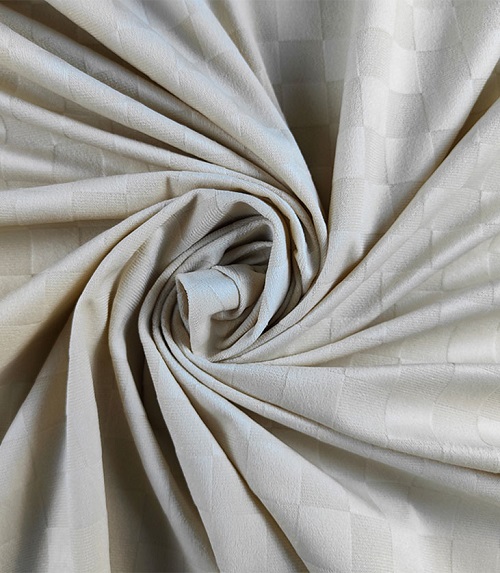In the evolving landscape of textiles, home wear fabric has become an increasingly critical category that blends comfort, aesthetics, and performance. Unlike conventional apparel fabrics designed for outdoor or formal wear, home wear fabrics focus on wearability, breathability, and softness for domestic environments. With the rise of lifestyle-driven consumer demand, loungewear, sleepwear, and multi-functional home attire have become a lucrative sector, emphasizing fabrics that satisfy not only sensory comfort but also durability, sustainability, and ease of care.
1. Defining Home Wear Fabric
Home wear fabric refers to textile materials specifically engineered for garments worn in indoor, relaxed, and semi-private contexts.
These fabrics differ from activewear or formal textiles by emphasizing:
- Soft hand feel: for skin-friendliness.
- Moisture management: for comfort during prolonged wear.
- Thermal regulation: suitable for indoor environments.
- Low maintenance: for frequent washing and drying.
- Aesthetic versatility: balancing casual fashion and functional use.
Key applications include pajamas, robes, loungewear sets, indoor layering, and multifunctional garments designed to transition from home to casual outdoor settings.
2. Fiber Selection and Material Properties
Natural Fibers
1. Cotton
- Properties: Soft, breathable, hypoallergenic, absorbent.
- Technical considerations: Prone to wrinkling and shrinkage; combed or mercerized cotton improves strength and sheen.
- Ideal for summer-weight pajamas and loungewear.
2. Linen
- Properties: Cool, moisture-wicking, and durable.
- Technical considerations: Wrinkles easily; often blended with cotton or viscose for softness.
3. Wool (including Merino)
- Properties: Thermal insulation, elasticity, moisture-regulating.
- Technical considerations: Requires anti-pilling and shrink-resistance finishing. Suitable for winter loungewear.
Man-Made Cellulosics
1. Viscose / Rayon
- Properties: Soft, drapable, comfortable.
- Limitations: Weak when wet, requires blending for stability.
- Used in silky loungewear and nightgowns.
Synthetic Fibers
1. Polyester & Microfiber
- Properties: Wrinkle-resistant, strong, quick-drying.
- Limitations: Less breathable; often engineered with micro-denier for softness.
- Applications: Plush robes, fleece home wear.
2. Nylon
- Properties: Lightweight, durable, smooth.
- Technical considerations: Often used in blends for stretch or sheen.
Blended Fibers
Blends are essential to achieve an optimal balance of softness, elasticity, durability, and thermal management.
Examples:
- Cotton/Polyester for wrinkle resistance.
- Modal/Spandex for stretch and drape.
- Wool/Nylon for warmth and durability.
3. Fabric Constructions
Knit Fabrics
- Jersey knit: Lightweight, stretchable, common in t-shirts and pajamas.
- Interlock knit: Thicker, smoother on both sides, provides warmth.
- Rib knit: Elastic, suitable for cuffs and waistbands.
- French terry & fleece: Brushed interiors for plush comfort.
Woven Fabrics
- Plain weave: Crisp, breathable (e.g., cotton poplin for pajamas).
- Twill weave: Durable with diagonal rib, used in heavier loungewear.
- Satin weave: Smooth, lustrous surface, common in luxury sleepwear.
Specialty Fabrics
- Pile fabrics (e.g., velour, terry): Soft surface textures, absorbent, cozy.
- Nonwoven fabrics (emerging in lightweight, disposable loungewear applications).
4. Textile Finishing for Home Wear
Technical finishes are critical for enhancing performance:
1. Mechanical Finishes
- Brushing, shearing, and sueding for softness.
- Calendaring for luster in satins.
2. Chemical Finishes
- Anti-pilling: to prevent fiber fuzzing.
- Wrinkle resistance: for easy care.
- Moisture management: (hydrophilic or hydrophobic finishes depending on fiber).
- Antimicrobial treatments: for odor control.
- Enzyme finishing: to reduce fuzz and enhance softness.
3. Functional Coatings
- Thermal-regulating finishes (e.g., phase change materials for year-round comfort).
- UV resistance for garments designed for indoor-outdoor hybrid wear.
5. Sustainability and Eco-Friendly Developments
With growing consumer demand for eco-conscious textiles, sustainability is a central focus in home wear fabrics:
- Organic cotton certified by GOTS.
- Bamboo, viscose, and regenerated fibers with reduced environmental impact.
- Closed-loop lyocell production with solvent recovery.
- Recycled polyester (rPET) from post-consumer waste.
- Natural dyeing methods to minimize chemical use.
Life cycle assessments (LCAs) are being adopted to evaluate environmental footprints, while circular fashion principles are increasingly applied in loungewear design.
6. Performance Testing and Quality Standards
Technical evaluation of home wear fabrics involves:
- Tensile and tear strength (ASTM D5034, D1424).
- Pilling resistance (Martindale or Random Tumble Pilling Test).
- Dimensional stability (after laundering cycles).
- Moisture vapor transmission rate (MVTR) for breathability.
- Thermal resistance (CLO value for warmth).
- Colorfastness (to washing, perspiration, and light).
- Fabric drape coefficient to assess comfort and aesthetic flow.
7. Market Trends and Future Directions
- Smart textiles: Incorporation of conductive fibers for thermal regulation and health monitoring.
- 3D knitting: Seamless loungewear production reducing fabric waste.
- Hybrid fabrics: Blending indoor comfort with athleisure properties.
- Customization: On-demand production of home wear tailored to consumer size, color, and performance preferences.
- Biodegradable synthetics: Development of polyester alternatives with accelerated compostability.
Home wear fabric is more than just a soft textile—it is an intersection of comfort engineering, material science, and sustainable design. From fiber selection and fabric construction to finishing technologies and eco-conscious innovations, the technical depth of this segment reflects the evolving lifestyle of modern consumers. As the boundary between indoor and outdoor wear continues to blur, future home wear fabrics will increasingly embody multifunctionality, sustainability, and smart technology integration.

